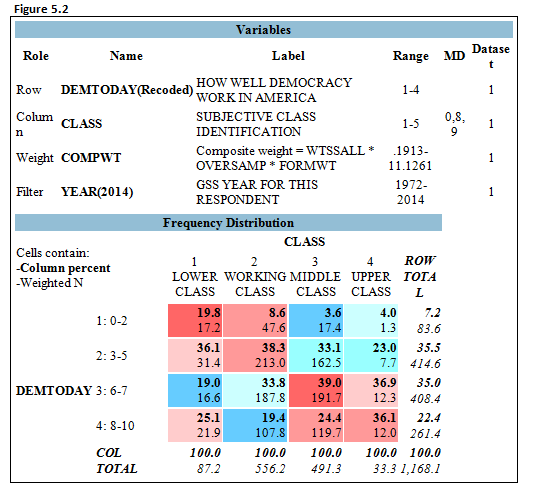Which of the following statements best describes the relationship between CLASS and DEMTODAY, as represented in Figure 5.2?
A researcher is interested to know whether people of different class backgrounds tend to hold different ideas about democracy. He creates Figure 5.2, where CLASS is a variable that indicates respondents’ sense of themselves as lower-class, working-class, middle-class, or upper-class. DEMTODAY is a variable corresponding to the question “On the whole, on a scale of 0 to 10 where 0 is very poorly and 10 is very well. How well does democracy work in America today?” The researcher re-coded DEMTODAY with the command “DEMTODAY (R: 0-2; 3-5; 6-7; 8-10).”

a. In general, there is a negative relationship between CLASS and DEMTODAY.
b. In general, as respondents’ class increases, they are more likely to believe that democracy in America is working very well.
c. Regardless of respondents’ class, most respondents believe that democracy in America is not working at all.
d. In general, as respondents’ class increases, the likelihood of their believing that democracy in America is not working well at all also increases.
b. In general, as respondents’ class increases, they are more likely to believe that democracy in America is working very well.
You might also like to view...
In the process of mate selection we (consciously or unconsciously) filter or sort through certain variables to determine if the person is someone we desire to partner with. The text lists five variables. What are they?
What will be an ideal response?
Many couples dismiss minor aggression as a sign of:
a. changing mores. b. homogamy. c. stress. d. sexual repression.
What perspective is most likely to consider elderly people as victims of ageism?
a. functionalist b. conflict perspective c. macro-level d. interactionist
While she wanted deeply to help, Delilah found she was uncomfortable teaching a particular target audience of families assigned to her, whose characteristics were outside of her lived experience and upbringing. She was likely experiencing a clash with which element of her philosophy about family life education?
a. Beliefs about the process of learning for families b. Beliefs about the purpose of family life education c. Beliefs about the content of family life education d. Beliefs about the family, its nature and quality